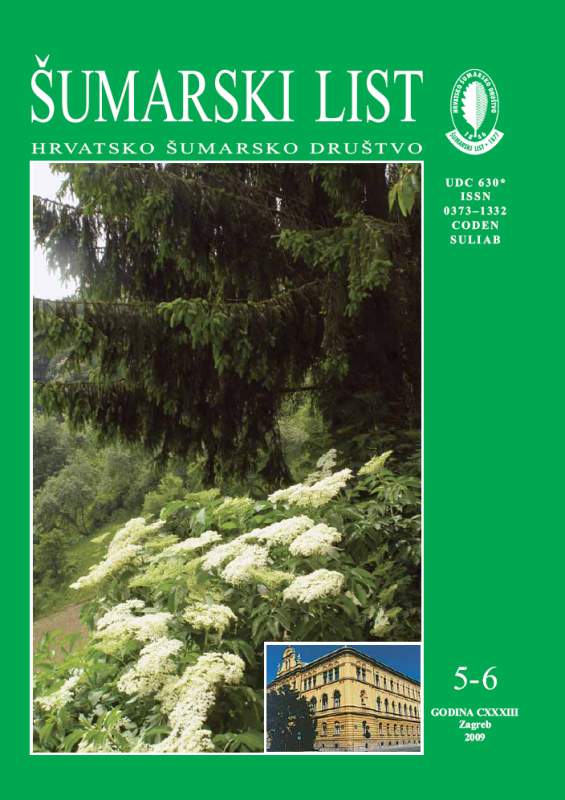
broj: 5-6/2009
pdf (3,4 MB) |
|
||||||||||||||
| RIJEČ GLAVNOGA UREDNIKA | ||
| Branimir Prpić | ||
| HOW TO SECURE THE FUTURE OF YOUNG, NATURALLY MANAGED FORESTS IN CROATIA DURING RECESSION pdf HR EN | 236 | |
| IZVORNI ZNANSTVENI ČLANCI | ||
| Tikvić, I., Ž. Zečić, D. Ugarković, D. Posarić | UDK 630* 429 + 851 (001) | |
| Damage of Forest Trees and Quality of Timber Assortmets of Pedunculate Oak on Spačva Area pdf HR EN | 237 | |
| Trinajstić, I., Z. Cerovečki | UDK 630* 188 (001) | |
| Festuco drymeiae-Fagetum Magic 1978 Association (Aremonio-Fagion) in the Vegetation of Northwest of Croatia pdf HR EN | 249 | |
| Roth, V., T. Dubravac, I. Pilaš, S. Dekanić, Z. Brekalo | UDK 630* 232.3 (001) | |
| Acorn Size of Pedunculate Oak (Quercus robur L.) and Sessile Oak (Quercus petraea Liebl.) as a Factor in Growth and Development of Seedlings pdf HR EN | 257 | |
| Jakovljević, T., K. Berković, G. Tartari, B. Vrbek, J. Vorkapić-Furač | UDK 630* 425 (001) | |
| Atmospheric Deposition in Forest Ecosystem of Europe and Research of New Methods for Determination of Phosphorus and Ammonia Within a Framework of ICP Forests pdf HR EN | 267 | |
| Degmečić, D., K. Krapinec, T. Florijančić | UDK 630* 156 (001) | |
| Factors that Determine Sex of Red Deer Calves (Cervus elaphus L.): Verification of Current Knowledge pdf HR EN | 279 | |
| Summary: One of the key factors of hunting economy is the question of reproduction, i.e. quality and sex ratio of the calves. This is especially important for those kinds of game, the males of which have a trophy. The density of population, dominance of hinds in the population and the amount of precipitation during winter (November-January), are definitely factors that influence the amount of food available (the first is negatively dependant, whereas the other two factors have a positive dependency on food availability), i.e. on the nourishment of the hinds. According to Flint et al. (1997) and Enright et al. (2001), the hinds that are better nourished give birth to a higher percentage of male calves, regardless if we are talking about red deer (Cervus elaphus L.) or fallow deer (Dama dama L.). Kojola’s research (1997) has confirmed similar results for reindeer (Rangifer tarandus L.), and Wauters et al. (1995) for roe deer (Capreolus capreolus L.). The research of the factors that may influence the sex of a red deer calf (Cervus elaphus L.) has been conducted in the State hunting ground number XIV/9 “PODUNAVLJE – PODRAVLJE”. The hunting ground is situated in Baranja alongside the rivers Danube and Drava. The hunting ground is managed by the company Hrvatske šume d.o.o. Zagreb, Uprava šuma podružnica Osijek. This paper is based on the cull data of the hinds in the hunting ground during the hunting seasons 2007/2008 (42 head) and 2008/2009 (23 head). The following data has been recorded and analyzed: net body weight of the hinds (body weight of eviscerated head with skin, without head and feet (carpal and tarsal parts of the extremities)); also during evisceration, embryos or foetuses were removed from uterus, weighed on a gram scale and their sex was determined in utero (Figure 2. and 3.). The research did not find differences that would point to this particular factor, although there is a change in ratio of male and female foetuses. For the hunting season 2007/2008 sex ratio was 1:21 (45:55 %) for the female foetuses, and a year after 1,09:1 (52:48 %) for the male foetuses (Table 1.). The cause of the irregular sex ratio in the hunting season 2007/2008 could be an extremely hot and very dry summer in 2007, or the difference could simply be caused by the sample examined. It was found that the sex ratio of the culled hinds in two consecutive hunting seasons (2007/2008 and 2008/2009) was different (1:21, and 1.09:1 respectively). The results of the net body weight tests for the hinds, as one of the key parameters for the population, did not show a significant relevance for determining the sex of future calves. However, although statistically insignificant, a climate difference in the summers of the two hunting seasons was recorded. Key words: Cervus elaphus; hind body weight; in utero; red deer; sex of the foetus | ||
| Potočić, N., I. Seletković, M. Čater, T. Ćosić, M. Šango, M. Vedriš | UDK 630* 232.3 + 422 | |
| Ecophysiological Response of Sun-Exposed Common Beech (Fagus Sylvatica L.) Seedlings under Different Fertilization Levels pdf HR EN | 289 | |
| Rosavec, R., D. Dominko, D. Barčić, D. Starešinić, Ž. Španjol, K. Biljaković, M. Ožura, N. Marković, D. Bognolo | UDK 630* 432.1 (001) | |
| Analysis of Distribution of Areas Affected by Forest Fires on Island of Brač, Island of Korčula and Island of Rab pdf HR EN | 301 | |
| PRETHODNO PRIOPĆENJE | ||
| Perić, S., J. Medak, I. Pilaš, B. Vrbek, M. Tijardović | UDK 630* 413 + 232 | |
| Initial Research Results of the Possibility of Revitalizing Očura II Querry with Autochthonous Tree and Shrub Species pdf HR EN | 309 | |
| PREGLEDNI ČLANCI | ||
| Konjević, D., U. Kierdorf, V. Njemirovskij, Z. Janicki, A. Slavica, K. Severin | UDK 630* 132 | |
| Wild Boar Tusk Pathology: An Overview of the Current Knowledge and Models of Reparation pdf HR EN | 319 | |
| STRUČNI ČLANCI | ||
| Frković, Alojzije | UDK 630* 156 | |
| The First Hunting Textbook of Bosnia and Herzegovina pdf HR EN | 327 | |


